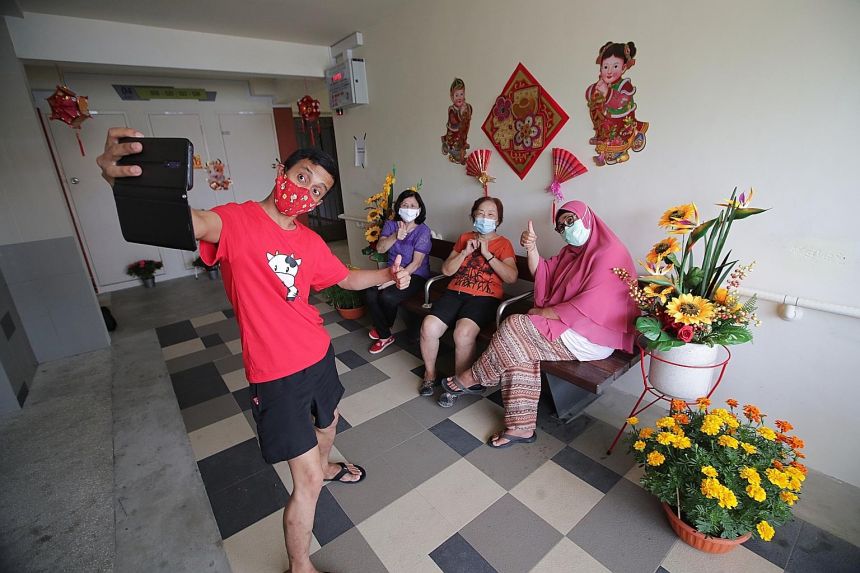Nearly 1 in 3 HDB blocks hit ethnic quota limits, shows relevance of EIP today: Desmond Lee
Sign up now: Get ST's newsletters delivered to your inbox

Mr Abdullah Abdul Rahman, 36, taking a wefie with his neighbours - (from far left) Madam Chen, Madam Mary Tay and Madam Rasida A. Rahman - in February this year.
ST PHOTO: GIN TAY
Follow topic:
SINGAPORE - Nearly one in three Housing Board blocks and 14 per cent of neighbourhoods today have reached ethnic quota limits, underscoring the importance of having the Ethnic Integration Policy (EIP) in place to ensure social mixing, said National Development Minister Desmond Lee.
The maxing out of racial quotas for flat ownership happens across all ethnic groups and in both mature and non-mature estates, he told the House on Monday (July 5), adding that the limits have persistently been reached in some areas such as Bukit Merah, Pasir Ris and Woodlands.
"So just imagine how much more different ethnic groups would concentrate in different neighbourhoods if we did away with the EIP, and how much harder it would then become to promote mixing and understanding across ethnic groups in the home environment," said Mr Lee.
Introduced in 1989, the EIP sets racial quotas on flat ownership within each HDB block and neighbourhood.
The policy remains relevant and necessary today amid changing household profiles, Mr Lee said in response to Ms Cheryl Chan (East Coast GRC) and Mr Chong Kee Hiong (Bishan-Toa Payoh GRC).
It serves an important function to ensure neighbourhoods remain inclusive and diverse, as people get to interact with neighbours of different races almost every day along corridors, void decks, playgrounds and markets, he added.
Mr Lee noted that some might argue that living next door to someone from a different race or religion does not mean people will learn to tolerate or understand differences. Others contend that social integration can be achieved in schools, at work or during national service.
But the EIP remains critical because so much of people's lives revolve around homes and neighbourhoods, he noted.
"If we don't live with one another, it makes it much harder to empathise with other communities and understand the challenges they face, and much easier to stereotype or assume the worst of those who are different from us. This is a recipe for mutual mistrust and intolerance."
Left entirely to social and market forces, ethnic concentrations will start forming in different areas again, he said.
This could be due to instinctive preferences to live near others from the same ethnic community, or wanting to live near family members or specific amenities in some neighbourhoods, Mr Lee noted. "Individually, these are completely understandable and reasonable preferences. But collectively, if we are not careful, these tendencies could inadvertently lead to segregation among the races," he said.
Children, for instance, could grow up in neighbourhoods where they hardly see children of other races in their classrooms, as most children go to pre-schools and primary schools near their homes.
Today, interracial households can choose which ethnic quota to be considered under when buying a flat, which is then fixed until they sell the flat, to be fair to other flat owners, said Mr Lee.
He also set out the historical context of the EIP.
When Singapore was still under the British rule, the Raffles Town Plan had designated separate geographical zones for each ethnic group, which meant different races had little interaction.
In resolving to build a cohesive, multiracial society, the country's founding leaders did not blindly paper over differences between ethnic groups or take a "melting pot" approach by having different races blend or conform artificially to one uniform culture, he noted.
Instead, the Government decided to enlarge the common spaces through a range of policies, such as allocating new flats to reflect ethnic mix of the general population.
But ethnic concentrations started to emerge in particular areas after resale transactions were allowed in 1971, Mr Lee said.
By the late 1980s, Chinese buyers were increasingly concentrated in Ang Mo Kio, and Malay buyers in Bedok and Tampines.
"We could see that without intervention, there would, once again, be increasing concentrations along ethnic lines which would have separated us," he said.
The EIP was thus introduced in 1989 for both new and resale flats to ensure estates remain diverse.
Mr Lee pointed to how racial segregation is common and well-advanced in some major European and American cities, with wealthier ethnicities congregating in expensive, gentrified precincts.
Less well-off ethnic groups are stigmatised and receive fewer opportunities, and these differences get entrenched across generations, he added.
Citing a data visualisation tool developed by the University of Virginia called the Racial Dot Map, which plots one dot for each person on the US map, with different colours representing different ethnicities, Mr Lee said the distinct patches of colour reflect a multicultural but segregated country.
Drawing from these lessons, he said Singapore cannot leave social mixing to chance.
"It is better to intervene upstream to pre-empt the problem and to foster mutual understanding and encourage integration from the start," he said.
"If we wait until after racial tensions have developed and become entrenched, it will become so much harder to heal those fractures and rebuild trust among different communities."

